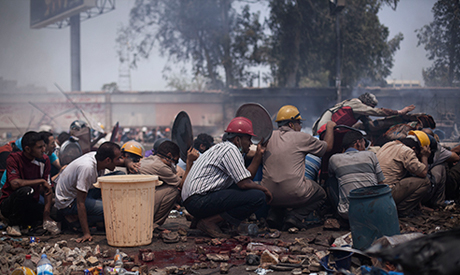
Supporters of ousted Egyptian President Mohamed Morsi during clashes in Rabaah Al-Adawiya in Cairo's Nasr City district, Egypt, Wednesday, Aug. 14, 2013. (Photo: AP)
A fact-finding committee formed to investigate events in Egypt since the ouster of president Mohamed Morsi announced on Wednesday that a total of 693 civilians and 10 police men died when security forces dispersed pro-Morsi sit-ins in greater Cairo on 14 August 2013.
Dispersal of the sit-in at Rabaa Al-Adawiya square in eastern Cairo left 607 civilians and eight policemen dead; while the smaller sit in at Nahda square in Giza saw the death of 86 civilians and two policemen, the committee said in a press conference on Wednesday.
The committee, headed by prominent judge Fouad Abdel-Moneim Riad, blamed pro-Morsi protesters for the wave of violence that swept the country before, during and after the dispersal of the sit-ins, especially attacks on Coptic Christians.
"The sit-in[s] were not peaceful neither before nor during the dispersal and all legal rationale were available for the police to forcibly break up the gathering after efforts for a voluntary evacuation failed," read the report.
At Rabaa, police aimed to clear the square and not kill protesters but had to respond to gunfire from armed demonstrators, the report added, saying that an ultimatum had been issued before the dispersal and that security forces had provided a safe exit for protesters, with some being forced to exit while others refused.
"Police gradually used force, first using water cannons and tear gas," the report said. "Live ammunition was only used after killing and injury occurred in its ranks.
"The report also said that although police were shot at, “they failed to aim their fire only at the sources of fire, which accordingly lead to an increase in the number of casualties.”
The government hesitated between dispersing the sit-in quickly, with all the side effects of such a decision, and dispersing it with fewer costs over a longer period of time. However, it chose the first option in order to protect the authority of the state, the report said.
“The government could have opted for drying up the human element of the sit-in, leading a wide media campaign to announce its intention to disperse the sit-in and get people involved in removing their sons from this non-peaceful protest,” the report added.
The committee made it clear that it does not have the authority to direct accusations to any party.
Riad, the committee's head, was appointed Judge of the International Criminal Tribunal for the former Yugoslavia in 1995. He is a member of the Institut de Droit International, and served from 1993 to 1995 as Vice-President.
Violence preceded and followed the ouster of Mohamed Morsi on 3 July 2013.
Supporters and opponents of Morsi frequently clashed while he was still in power. Days before his ouster, supporters formed sit-ins to counter protests demanding his removal from power.
The two main pro-Morsi sit-ins were at Cairo's Rabaa Al-Adawiya Square and Giza's Nahda Square.
Morsi's ouster was announced by then army chief and current president Abdel-Fattah El-Sisi, backed by representatives of political parties and religious figures.
In August, a month after Morsi's ouster, security forces dispersed the sit-ins, leading to violence that took place in many parts of the country.
Churches and the homes of Coptic Christians were attacked and torched in several parts of Egypt following the dispersal. Islamists had often blamed Egypt's Christians for the anti-Morsi protests that led to his ouster.
Short link: